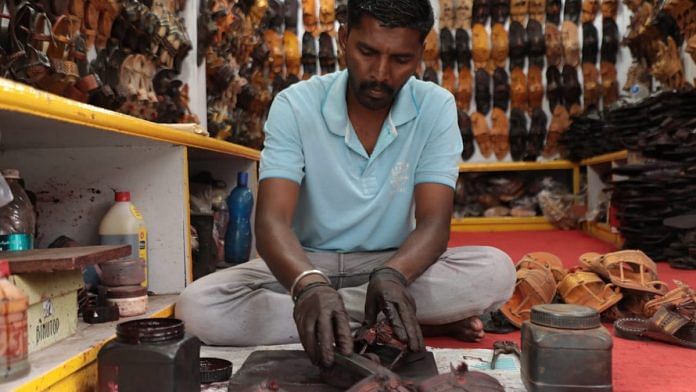Kolhapur: In a small veranda workshop in Kolhapur’s Subhash Nagar, 60-year-old Ramesh thins the edges of a camel-brown leather cut-out, the base of a Kolhapuri chappal. He’s done this work for 45 years, through falling orders and fading interest. But now, for the first time in a while, a sense of possibility mingles with the smell of leather in the air.
A sandal shown by Prada at Milan Fashion Week looked almost exactly like the ones made in this lane, also known as Chappal Gali. The controversy that followed is the most attention the town’s artisans have seen in years. Anger has turned into hope.
“In the early 2000s, from 7 am to 5 pm, hammers would ring nonstop in Subhash Nagar. Now it’s fallen quiet. Only the elderly are left,” said Shubham Satpute, a fourth-generation artisan and trader who owns the workshop, Inga Leathers, where Ramesh is crafting the chappal. “This is a big moment for us.”
For these artisans, most of whom are Dalits, it’s not just a shot at better pay or recognition, but at getting society to acknowledge the dignity of their labour, Satpute added.
The Kolhapuri sandal craft is a fading cottage industry, struggling to survive amid stagnant demand, poor pay, and an identity crisis. Fewer young people are taking it up, pushing the craft to the edge of extinction.
But the recent controversy around Prada’s Kolhapuri-inspired footwear, launched as part of its Spring/Summer 2026 menswear collection in Milan, has changed things.
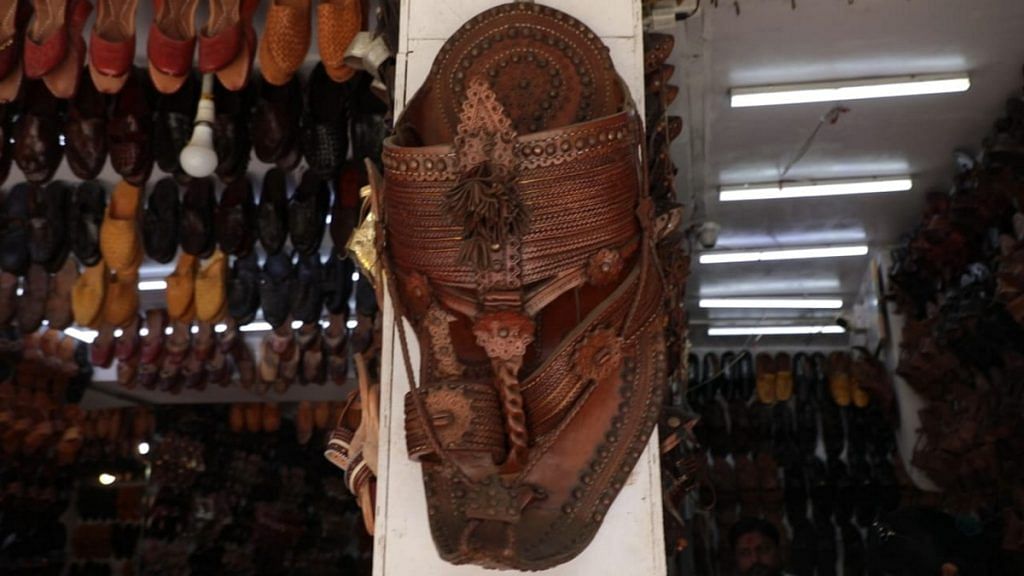
The brand didn’t credit the design’s roots, but the resemblance was hard to miss. There was outrage on social media. Celebrities like Kareena Kapoor and Neena Gupta weighed in. It became one of the more striking cases of cultural appropriation in recent memory. The Kolhapuri sandal, which got its GI tag in 2019, joined the long list of Indian styles ‘rebranded’ for Western runways —bindis, dupattas turned Scandi scarves, kamarbands turned cummerbunds, jholas and mandi bags sold as designer totes. Prada finally acknowledged the artisans. And Kolhapur was back in the spotlight.
Almost overnight, Kolhapuri sandals went from being a common man’s item to a symbol of luxury, just because Prada’s name got associated with it. It gave them a new level of respect in the eyes of the public
-Lalit Gandhi, president of Maharashtra Chamber of Commerce, Industry and Agriculture (MACCIA)
The backlash forced Prada’s technical team to visit Kolhapur, meet with artisans, and suggest a potential collaboration. Plans for training centres and global exposure are in discussion. For artisans long overlooked, it’s a glimpse into a future they’d never imagined before.
“This could bring global recognition to both Kolhapur and the Kolhapuri chappal,” said Satpute, who is striving to preserve the legacy his great-grandfather began in 1902. “It could also bring back the younger generation that once abandoned the craft in pursuit of ‘respectable’ corporate careers, because now, saying you make sandals for an international luxury brand like Prada will earn instant social validation.”
Also Read: Manish Malhotra looks back at DDLJ 30 years later. ‘Designing for Simran wasn’t about fashion’
More than a buzz
During Prada’s visit, artisans at Inga Leathers gifted the team a pair of Mauje Puda Kapshi Kolhapuri chappals, an open-toed, T-strap design with distinctive puda-style braiding.
This design, passed down through many generations, was the reference for Prada’s controversial sandals, Satpute said.
“It’s the same ancient design they used. That’s why it sparked such a reaction,” he added. To set the record straight, he even made an Instagram video explaining the heritage of the design. It amassed over five lakh views. Other videos from his account also took off. One Reel, showing the Prada team’s visit to his shop, got 1.6 million views.
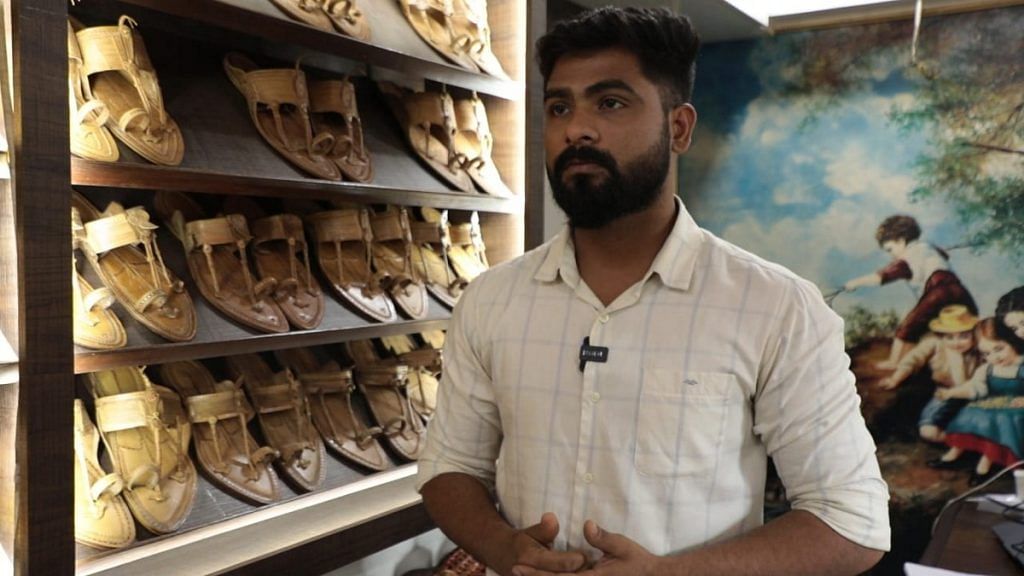
Over the past few weeks, his follower count jumped from 4,000 to over 10,000. At the same time, sales also shot up.
“I have run out of stock, thanks to all the social media buzz,” he said.
But artisans and shopkeepers want more than a temporary spotlight. They’re on tenterhooks, waiting to see if the Prada collaboration actually pans out.
You could see the surprise in [the Prada team’s] eyes as we explained the step-by-step procedure. They asked many technical questions, like how the thin braids are made
-Shubham Satpute, owner of Inga Leathers
Prasad Shate, who runs a Kolhapuri sandal shop in Shivaji Chowk, said it isn’t just about profit margins. A partnership with Prada could open doors to a better quality of life for artisans and improve the chances of the next generation taking it up. They’re also looking to the Maharashtra Chamber of Commerce, Industry and Agriculture (MACCIA).
“We’ve asked MACCIA to set up a training centre in Subhash Nagar where young people can learn the craft in a modern, structured way,” Shate said.
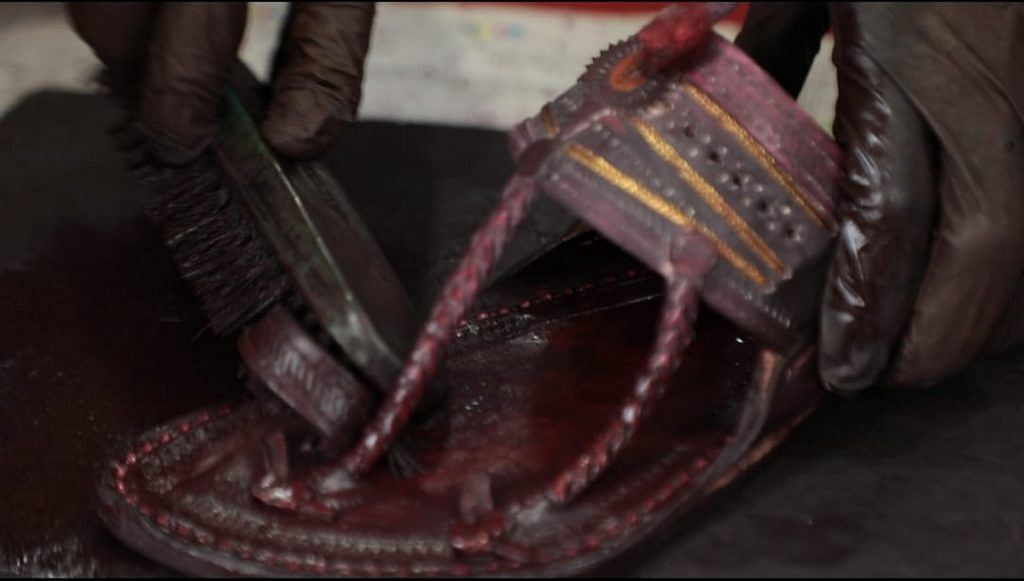
MACCIA president Lalit Gandhi said he discussed this idea with Prada and has suggested that the brand open an ‘Excellence Lab’ in Kolhapur to train artisans in traditional methods and global quality standards.
While Satpute agrees that the Prada name could attract young people back to the trade and bring them clout in their social circles, he also has a healthy distrust of machines and mass manufacturing.
For him, the heart of Kolhapuri craftsmanship lies in the touch of human hands.
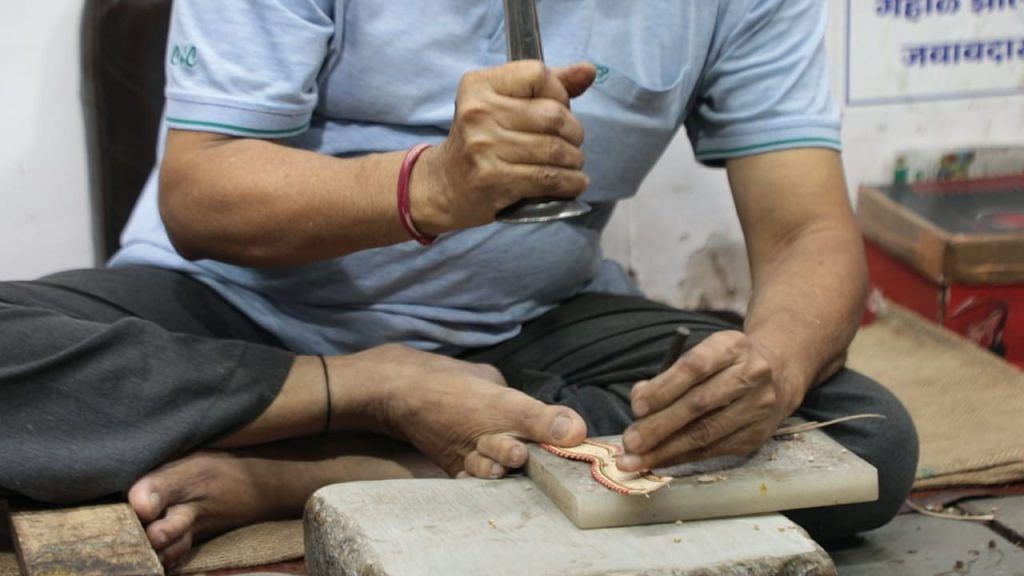
Many of these sandals are crafted by husband-and-wife teams, he said. While the husband takes on the physically demanding tasks, the wife handles the intricate detailing. This collaboration, according to him, can’t be replicated by machines.
“Too many hands on one pair of sandals will spoil it. Similarly, if machines take over, the essence is lost,” Satpute said.
For brands like Prada, uniqueness is a selling point, but for Kolhapur artisans, it’s just a natural default.
“No two handmade Kolhapuri sandals are ever exactly the same. It’s unintentionally customised,” he smiled.
Everyday sandal to luxury fashion
The Kolhapuri sandal industry has grown by Rs 4,000 crore over the past five years, with an estimated market value of around Rs 15,000 crore, said MACCIA president Lalit Gandhi. But that figure, he cautioned, doesn’t reflect a boom in demand.
“The market value has risen not because more sandals are being sold, but due to reduced production and inflation driving up prices,” he said.
Kolhapur, which houses one of the 51 Shakti Peeths, sees a regular stream of pilgrims and visitors from nearby districts. Many pick up Kolhapuri chappals from local markets. But according to shopkeepers, the sandals don’t have the same must-have status as some other regional crafts.
“The way people travel to Banaras specifically for the sarees, that doesn’t quite happen with Kolhapuri chappals,” said Shate.
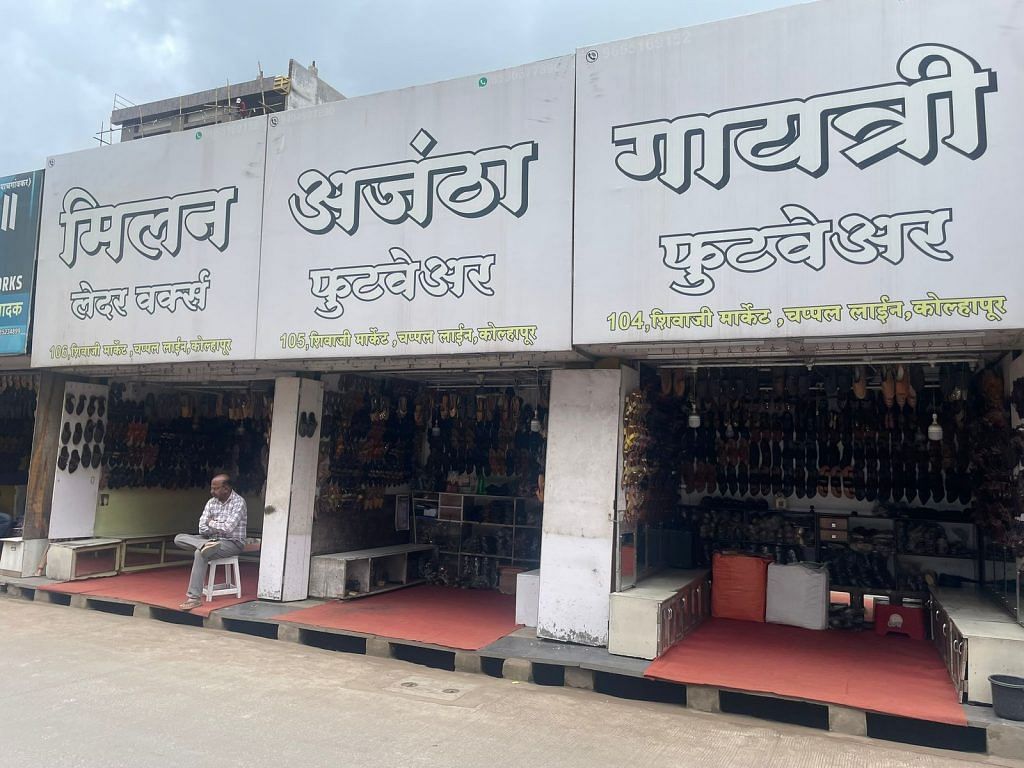
Exports are also modest. Traders say low production capacity and lack of organised support have kept the craft confined mostly to regional markets. Many buyers also opt for cheaper machine-made versions.
In terms of their market positioning, Kolhapuris are going through a spell of identity confusion. Traditionally a commodity meant for the daily use of common people, they’re now priced out of the budget of such consumers. A Kapshi sandal for men that sold for Rs 1,500–2,000 in 2015 now retails for upwards of Rs 2,400. At the same time, those who can afford them don’t particularly covet them. That’s the perception that now has a chance of shifting.

“Almost overnight, Kolhapuri sandals went from being a common man’s item to a symbol of luxury, just because Prada’s name got associated with it,” Gandhi said. “It gave them a new level of respect in the eyes of the public.”
Gandhi first saw Prada’s Kolhapuri-inspired sandal on 24 June, when his nephew showed him Instagram Reels from the Milan show. While he was still processing it, a group of artisans and shopkeepers reached out to him, angry that their craft had been copied without any credit. They asked Gandhi to act.
He wrote to Prada the next day.
In his email dated 25 June 2025, Gandhi urged the brand to publicly acknowledge the design’s origin and consider revenue-sharing with Kolhapuri artisans, especially since they priced the footwear at the equivalent of Rs 1,16,000.
The way people travel to Banaras specifically for the sarees, that doesn’t quite happen with Kolhapuri chappals
-Prasad Shate, trader
He said that Prada confirmed in their reply that the design was indeed based on the Kolhapuri sandal. However, the company told him they would acknowledge this only at the time of the commercial launch, the date of which is yet to be announced.
“Later during a Zoom call, on 11 July, we also asked them to source directly from Kolhapuri artisans and even promised to meet their quality standards,” Gandhi said.
Four days later, Prada’s technical team arrived in Kolhapur.
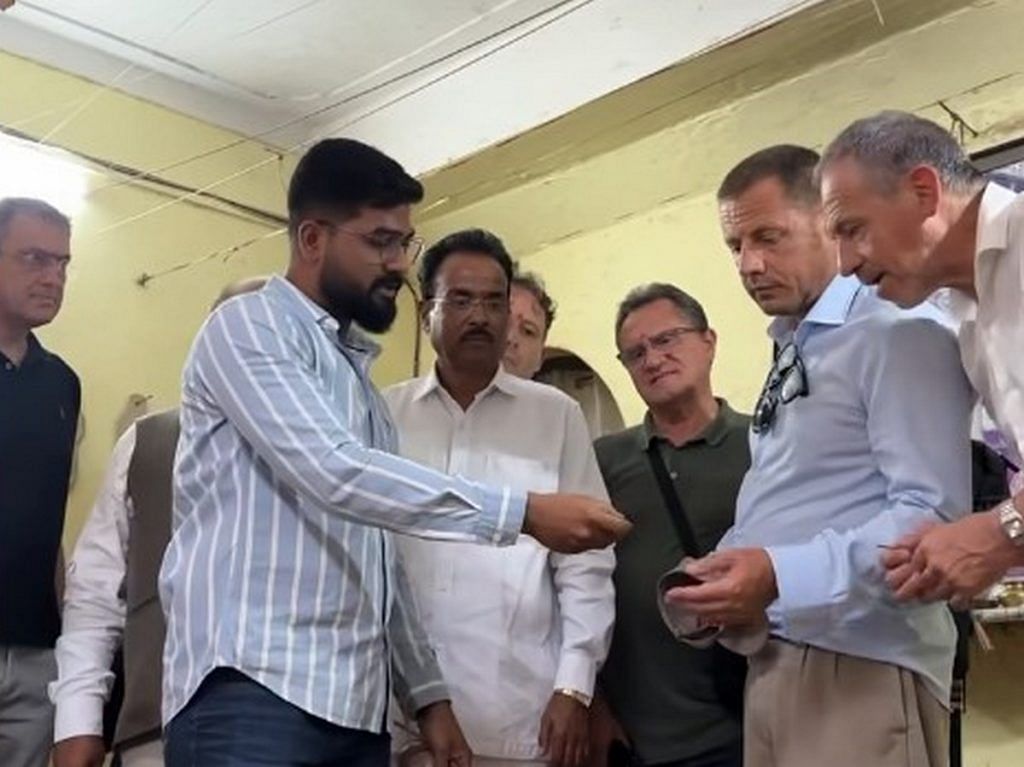
At first, the visitors seemed to think the sandals were machine-made, Satpute said, but when they walked through the workshops and saw each step carried out by hand, they were visibly surprised.
“You could see the surprise in their eyes as we explained the step-by-step procedure,” said Satpute. The team did not say much but were curious about the techniques and peppered the artisans with queries.
“They asked many technical questions about the procedure, like how the thin braids are made,” Satpute recalled.
Subsequently, Prada acknowledged the artisans more explicitly in a letter to MACCIA: “We acknowledge that the sandals featured in the recent Prada Men’s 2026 Fashion Show are inspired by traditional Indian handcrafted footwear, with a centuries-old heritage. We deeply recognize the cultural significance of such Indian craftsmanship.”
Also Read: What Prada did in Kolhapur—bought 7 pairs of Kolhapuris, spent 2 days at factory units
Art of making a Kolhapuri
The craft of Kolhapuri sandals relies on two marginalised communities. It starts with the Dhor community, based about 30 km away in Ichalkaranji, which handles the tanning of raw hides.
Each region has its own tanning style, and Kolhapur is known for the traditional bag-tan method, which uses vegetable dye and takes around 15 to 22 days.
“It’s similar to how we prepare pickles using salt, spices, and oil,” explained Satpute. “We use natural ingredients like babbool bark and hirada (myrobalan fruits) to preserve the animal hide.”
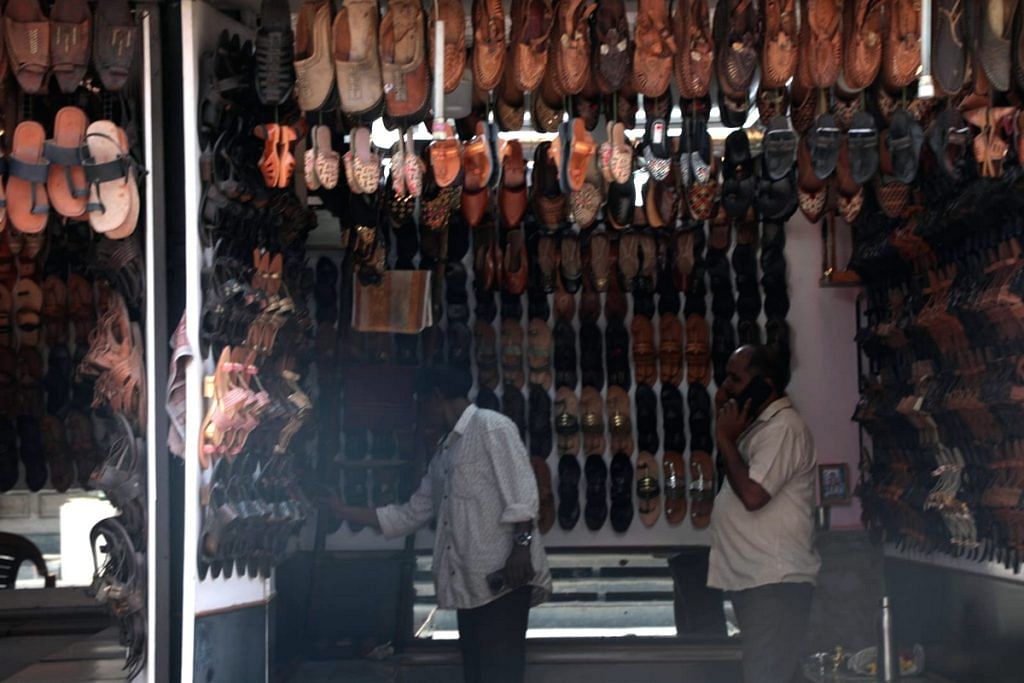
Although buffalo skin is naturally dark, Kolhapuri chappals have a signature light-brown colour. That, Satpute said, comes from the natural tanning agents. If the leather is any other shade, it likely means chemical-based treatments were used.
Once the leather is ready, the Dhor community sells it to local artisans, mostly from the Chambhar community, who then craft it into Kolhapuri sandals, usually in the small houses lining the narrow and unpaved Chappal Gali.
In one such house, a middle-aged woman, Bharthi, sits cross-legged on the floor in a green floral saree, carefully braiding strips of tanned sheep leather. Women in the community are responsible for the intricate work—braiding, stamping, and attaching the T-strap to the toe ring.
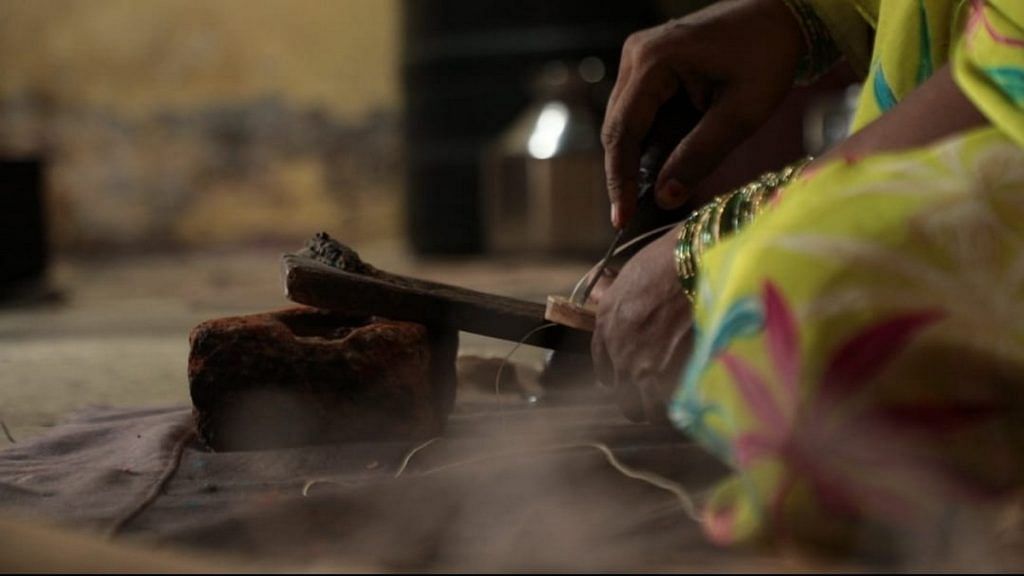
“I learned it from my father, and later my husband taught me the finer sheep braiding used in the strap of Kapshi,” said 53-year-old Bharthi, with a bunch of sandal bases kept to one side.
On a good day, she earns between Rs 500 and Rs 1,000. But during the monsoon, business slows down.
Many of these shops are now run by second-, third-, even fourth-generation owners. For them, the shop is more than just a place of business—it’s sacred. Customers are expected to remove their shoes before entering. Inside, the air carries the rich scent of rose and sandalwood.
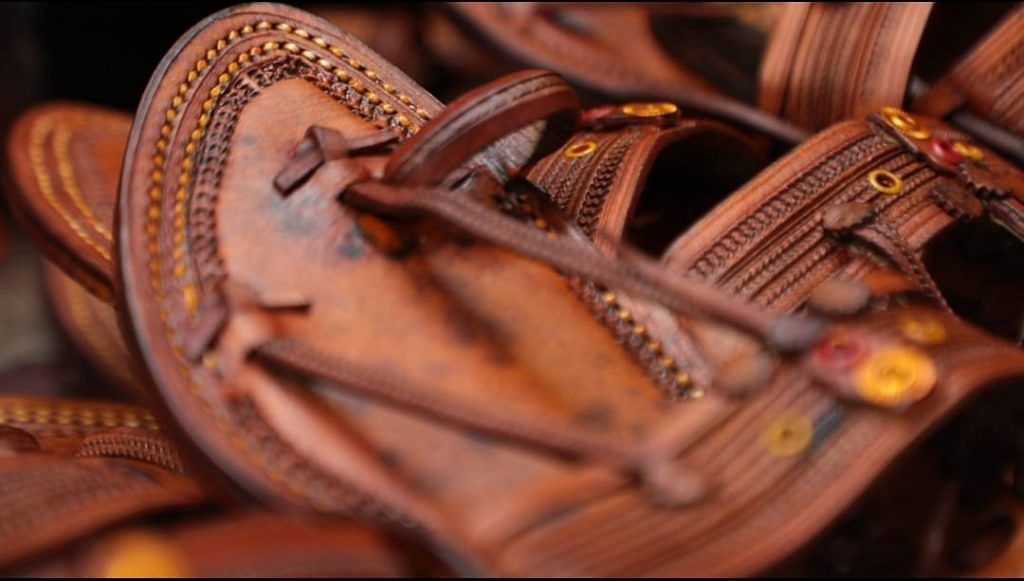
Prasad Shate, who runs his father’s 70-year-old business, said that while there are many variations of Kolhapuris, the four main styles are: Kapshi, Khaas Kolhapuri, Kurundwadi, and Buiwadi. Each of these has multiple subtypes.
The differences lie in the ‘kaan’ (ear-like side flap), the braiding, the leaf, T-strap, stitching, colour, and embellishments.
The type of leather varies as well and is a factor in the price, according to Shate. Buffalo hide is the cheapest; ox hide is the most expensive. Cowhide used to be the priciest, but with the closure of slaughterhouses, it’s no longer available.
Over the years, artisans have also adapted to changing markets by using rubber soles. At Shate’s shop, a pair made with animal hide and a rubber sole sells for Rs 600-700, while a fully traditional pair crafted entirely from leather using age-old techniques starts at Rs 1,800.
“The price goes up to Rs 30,000-35,000, depending on which animal hide is used,” Shate said.
Twenty years ago, Kolhapur had over 10,000 artisans, according to the Kolhapur Chappal Association. Today, only 2,000 to 3,000 still practise the craft.
Satpute’s workshop now hums with the steady rhythm of 12-13 seasoned artisans, all in their 40s and older. But what he hopes for is a space where wrinkled, time-tested hands work side by side with young, eager ones.
“That’s the only way this 800-year-old craft will survive,” he said.
(Edited by Asavari Singh)


